Korea-India relations date back to the Garak Kingdom in AD 48
By Publisher Lee Kyung-sik
President-elect Yoon Suk-yeol had a telephone conversation with Naranda Modi of India on March 17, 2022 and discussed ways to further develop and promote relations between the Republic of Korea and India. This shows the importance of India to Korea along with the United States, Japan, the United Kingdom and Australia, the so-called Quad nations.
Yoon said that he would actively promote close relations and cooperation with India and other member countries of Quad.
President-elect Yoon spoke with Prime Minister Modi for over 20 minutes over the phone on that day, according to Yoon’s Spokesperson Mme. Kim Eun-hye.
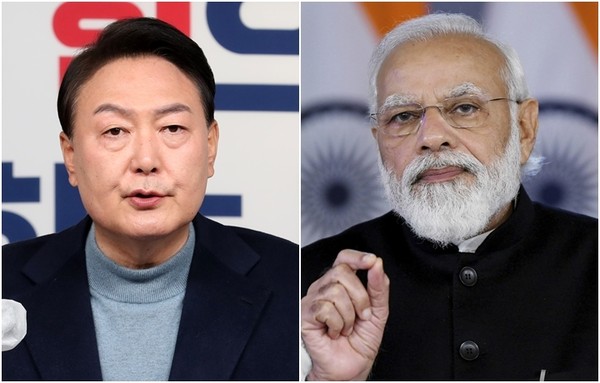
When Prime Minister Modi congratulated President-elect Yoon and wished that the new Korean President would enjoy a successful tour of office, Yoon replied to Modi that he extended his hearty congratulations saying, “Excellency, I extend my hearty congratulations on the wonderful results of the local elections!”
Historically, Korea and India are brother countries, according to the historical accounts of Samguk Yusa, as introduced by the Republic of Korea National Institute of Korean History (NIKH).
According to the NIKH accounts on the historical relations between Korea and India, King Kim Suro of the Garak Kingdom of Korea (AD 42-199) married Ayuta Princess Ayuta from India, which made Korea and India in-law countries. The Queen later got a Korean name, Heo Hwang-ok.
Earlier, the senior ministers of King Kim Suro recommended to the King to find a beautiful lady and greet her as his Queen. However, King Kim Suro adamantly refused this saying that his Queen would come from above the Heaven, which eventually was the Princess of India.

According to a report by NDTV of India, relations between Korea and India go back to the first century when an Indian Princess travelled from the Kingdom of Ayodhya to Korea by a boat. She married the Korean King Suro and became the first queen of South Korean kingdom.
Millions of Koreans trace their origins to Suriratna, a princess from Ayodhya, who had married the Korean Kng Kim Suro.
At a two-day international conference organized by the Indian Council for Cultural Relations (ICCR), Deputy Head of the Korean Embassy Ahn Min Sik in India said that the shared heritage between India and Korea began in 48 AD with Princess Ayodhya of India marrying King Kim Suro of Korea.
“If there's any country who is closer to India in terms of the shared history, the language, the country is Korea,” said the ICCR President Lokesh Chandra, adding that the legend has helped in strengthening Indo-Korean relations.
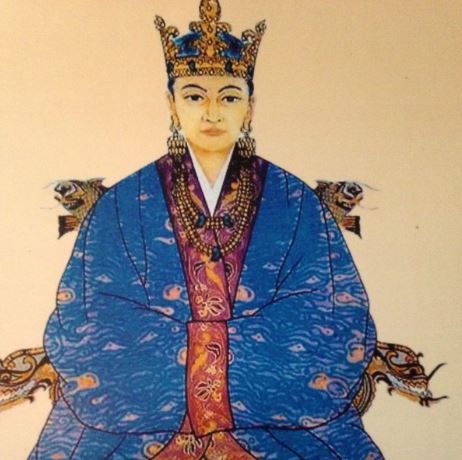
Secretary Anil Wadhwa at the Ministry of External Affairs of India said while addressing a conference: “Our history shows the mutual support and partnership which the two countries had enjoyed. This has led to an increasing value to our extending partnership in economic, political and cultural entities.”
An official statement from the ICCR pointed out that Suriratna had travelled for three months from Ayodhya to Korea by sea and married King Kim Suro of Korea, thus marking the beginning of the Garak clan in Korea.
Wikipedia encyclopedia also has an adequate measure of account on King Kim Suro and Queen Ayuta.

Queen Heo is a legendary Queen mentioned in Samguk Yusa, a 13th-century Korean chronicle. According to Samguk Yusa, she became the wife of King Suro of Geumgwan Gaya at the age of 16, after having arrived by boat from a distant kingdom called Ayuta making her the first Queen of Geumgwan Gaya.
More than six million present-day Koreans, especially from Gimhae Kim, Heo and Lee clans, trace their lineage to the legendary Queen as the direct descendants of her 12 children with King Suro.
Her native kingdom is believed to be located in India. There is a tomb in Gimhae, South Korea, that is believed to be hers, and a memorial in Ayodhya, India.
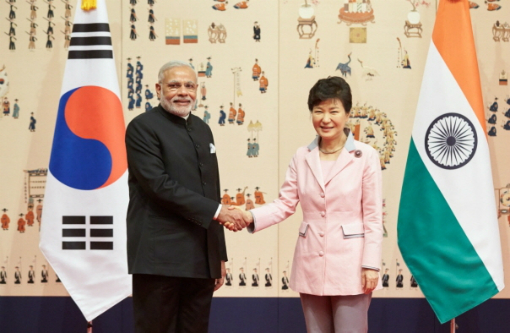
The legend of Heo is found in Garakgukgi (the Record of Garak Kingdom) which is currently lost, but referenced within the Samguk Yusa. According to the legend, Heo was a princess of the "Ayuta Kingdom."
Written sources and popular culture often associate Ayuta with India. Kim Byung-mo, an anthropologist from Hanyang University, identified Ayuta with Ayodhya in India based on phonetic similarity. Grafton K. Mintz and Ha Tae-hung implied that the Korean reference was actually to the Ayutthaya Kingdom of Thailand. However, according to George Cœdès, the Thai city was not founded until the year 1350, after the composition of Samguk Yusa
Marriage to Suro:
After their marriage, Heo told King Suro that she was 16 years old. She stated her given name as "Hwang-ok" (Yellow Jade) and her family name as Heo). She described how she came to Gaya as follows:
The Heavenly Lord (Sange Je) appeared in her parents' dreams. He told them to send Heo to Suro, who had been chosen as the king of Gaya. The dream showed that the king had not yet found a queen. Heo's father then told her to go to Suro. After two months of a sea journey, she found Beondo, a peach which fruited only every 3.000 years.
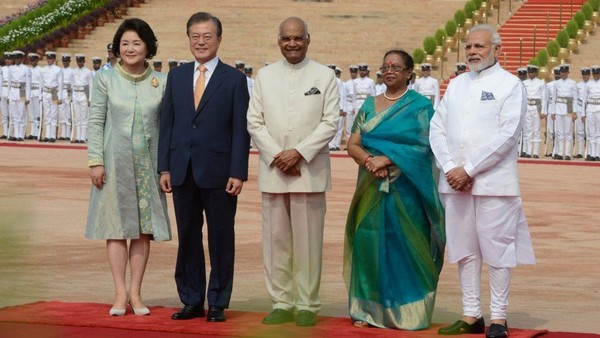
According to the legend, the courtiers of King Suro had requested him to select a wife from among the maidens they would bring to the court. However, Suro stated that his selection of a wife will be commanded by the Heaven.
He commanded Yucheon-gan to take a horse and a boat to Mangsan-do, an island to the south of the capital. At Mangsan, Yucheon saw a vessel with a red sail and a red flag.
He sailed to the vessel, and escorted it to the shores of Kaya (or Gaya, present-day Gimhae). Another officer, Sin Gwi-gan went to the palace, and informed the King of the vessel's arrival. The King sent nine clan chiefs, asking them to escort the ship's passengers to the royal palace.
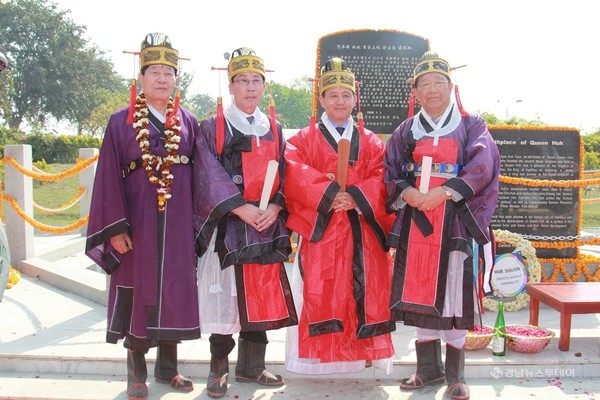
Princess Heo stated that she wouldn't accompany the strangers. Accordingly, the King ordered a tent to be pitched on the slopes of a hill near the palace.
The princess then arrived at the tent with her courtiers and slaves. The courtiers included Sin Bo and Jo Gwang. Their wives were Mojeong and Moryang, respectively.
The twenty slaves carried gold, silver, jewels, silk brocade, and tableware. Before marrying the King, the Princess took off her silk trousers (mentioned as a skirt in a different section of Samguk Yusa) and offered them to the mountain spirit. King Suro tells her that he also knew about Heo's arrival in advance, and therefore, did not marry the maidens recommended by his courtiers.
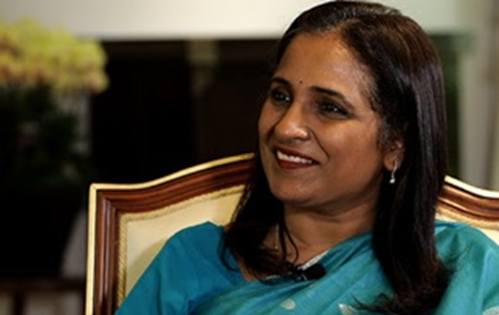
When some of the Queen's escorts decided to return home, King Suro gave each of them thirty rolls of hempen cloth (one roll was of 40 yards). He also gave each person ten bags of rice for the return voyage.
A part of the Queen's original convoy, including the two courtiers and their wives, stayed back with her. The queen was given a residence in the inner palace, while the two courtiers and their wives were given separate residences. The rest of her convoy were given a guest house of twenty rooms.
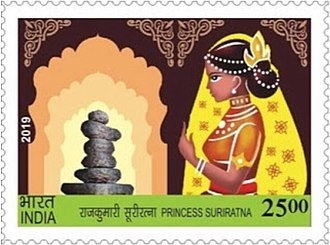
Descendants:
Queen Heo and Suro had 12 children and the eldest son was Geodeung.
The Queen requested King Suro to let two of the children bear her maiden surname. Legendary genealogical records trace the origins of the Gimhae Heo to these two children. The Gimhae Kims trace their origin to the other eight sons, and so does the Yi clan of Incheon.
According to the Jilburam, the remaining sons are said to have followed in their maternal uncle Po-ok's footsteps and devoted themselves to Buddhist meditation. They were named Hyejin, Gakcho, Jigam, Deonggyeon, Dumu, Jeongheong and Gyejang. Overall, more than six million Koreans trace their lineage to Queen Heo from India.
The remaining two children were daughters who were married respectively to a son of Talhae and a noble from Silla.
The legend states that the Queen died at the age of 157.
Madam Kim Yoon-ok, the First Lady of former President Lee Myung-bak, traces her ancestry to the royal family.
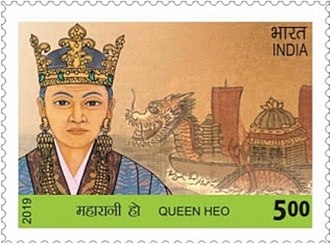
Queen Suro's Tomb (Queen Heo Hwang-ok) is located in Gimhae in Korea.
The tombs believed to be that of Heo Hwang-ok and Suro are located in Gimhae, South Korea. A pagoda traditionally held to have been brought to Korea on her ship is located near her grave.
The Samguk Yusa reports that the pagoda was erected on her ship in order to calm the god of the ocean and allow the ship to pass. The unusual and rough form of this pagoda, unlike any other in Korea, may lend some credence to the account.
A passage in the Samguk Yusa indicates that King Jilji built a Buddhist temple for the ancestral Queen Heo on the spot where she and King Suro were married. He called the temple Wanghusa ("the Queen's Temple") and provided it with ten gyeol of stipend land. A gyeol, varied in size from 2.2 acres to 9 acres (8,903-36,422 m2) depending upon the fertility of the land.
Samguk Yusa also records that the temple was built in 452. Since there is no other record of Buddhism having been adopted in 5th-century Gaya, modern scholars have interpreted this as an ancestral shrine rather than a Buddhist temple.
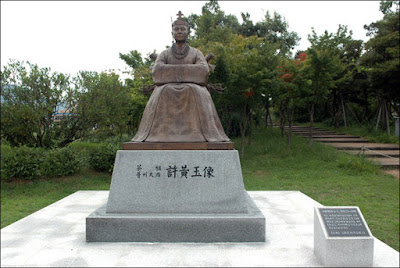
Memorial of Heo Hwang-ok, Ayodhya:
In 2001, a Memorial of Heo Hwang-ok was inaugurated by a Korean delegation, which included over a hundred historians and government representatives. In 2016, a Korean delegation proposed to develop the memorial. The proposal was accepted by then-Chief Minister of Uttar Pradesh, Akhilesh Yadav.
On Nov. 6, 2018 on the eve of Diwali celebration, First Lady Kim Jung-sook (of President Moon Jae-in), laid the foundation stone for the expansion and beautification of the existing memorial.
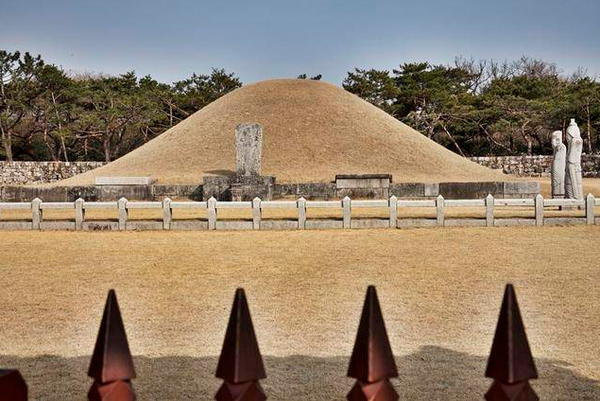
She offered tribute at the Queen Heo Memorial, attended a ceremony for the upgrade and beautification of the memorial and attended an elaborate Diwali celebration at Ayodhya along with Chief Minister Yogi Adityanath, that included cultural shows and lighting of 300,000-plus lights on the banks of Sarayu River.
Reportedly, hundreds of Koreans visit Ayodhya every year to pay homage to their legendary Queen Heo Hwang-ok.
In February 2019, India and Korea signed an agreement on releasing a joint stamp, commemorating Queen Heo Hwang-ok.
Indian Council for Cultural Relations is releasing book that includes contact between foreign cultures and India, which mentions the story of Queen Heo Hwang-ok.


